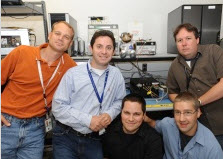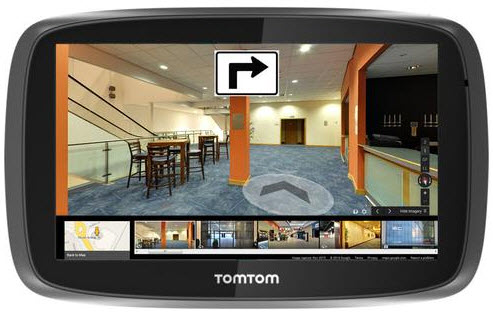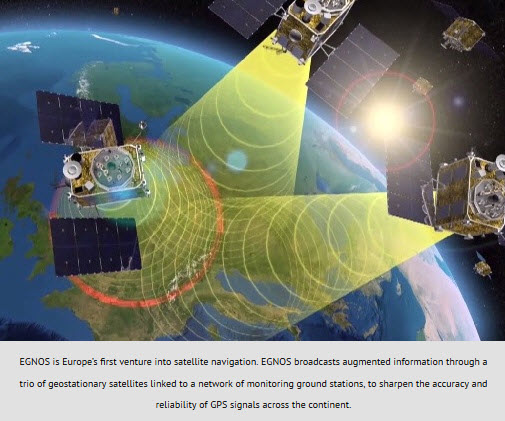Navigator Technology Takes GPS to a New High
8 September 2014

GPS navigational devices are as ubiquitous as cell phones, freely used by commercial and government users alike to determine location, time, and velocity. These tools, however, are only as good as the signals they receive. Now, NASA engineers have found a way to improve the reception of those signals.
GPS, which stands for the Global Positioning System, is a satellite-based navigation system made up of a network of 24 satellites placed into orbit by the U.S. Department of Defense. GPS originally was intended for military uses, but in the 1980s, the government made the system available for civilian use. GPS systems now are available to users worldwide who need accurate positioning, navigation, and timing services.
Thanks to a team of engineers from the NASA Goddard Space Flight Center in Greenbelt, Md., spacecraft operating in weak-signal areas — such as geosynchronous orbits where communications and weather satellites typically operate — will be able to acquire and track the weak GPS signals to determine their locations, much like motorists who use GPS to determine where they are. For their work developing the Navigator GPS receiver, the Goddard team was nominated for the coveted NASA "Invention of the Year" award, a prize reserved for NASA employees who have secured patents for their inventions. An announcement is expected shortly.
Although millions of people rely on GPS receivers today for terrestrial applications, onboard GPS navigation for spaceflight operations has been much more challenging — particularly for spacecraft operating above the GPS constellation, which is about 20,200 kilometers (12,727 miles) above Earth in an area normally referred to as high-Earth orbit. That is because existing GPS receivers could not adequately pick up the GPS signal, which is transmitted toward Earth, not away from it. As a result, spacecraft above the constellation could not reliably use GPS for tracking and navigational purposes, forcing them to use more expensive ground-tracking assets.
Seeing an opportunity to help lower mission costs, the Navigator team, led by Goddard engineer Luke Winternitz, used Research and Development (R&D) funding to develop algorithms and hardware for a prototype spacecraft GPS receiver that would allow spacecraft to acquire and track weak GPS signals at an altitude of 100,000 km (62,137 miles) — well above the GPS constellation, roughly one quarter of the distance to the moon.
"The R&D investment allowed us to develop the weak-signal Navigator GPS receiver and bring it to fruition," Winternitz says. "Proof of the value of this investment lies in the explosion of flight opportunities and commercialization ventures that have followed."
Since its development, the technology has secured flight opportunities on several new missions. Navigator will serve as the primary navigation sensor on NASA’s Global Precipitation Measurement Mission (GPM), which will study global rain and snowfall when it launches in 2013.
It is considered the enabling navigation technology for another Goddard-managed project, the Magnetospheric MultiScale (MMS) mission. The mission is made up of four identically instrumented spacecraft that will fly in formation in a very high-altitude Earth orbit, while measuring the 3-D structure and dynamics of Earth’s protective magnetosphere. The mission will rely on the Navigator GPS receiver’s improved sensitivity to help the satellites maintain their precise orbital position.
The Air Force Research Laboratory (AFRL) at Kirtland Air Force Base, N.M. is planning to use a Navigator engineering test unit in its "Plug-and-Play" spacecraft, an experimental satellite that can be developed and launched within days because it uses components that hook together in a manner similar to how a computer adds drives or printers via a Universal Serial Bus interface.
The Navigator team also has delivered an engineering test unit to the next-generation weather satellite called GOES-R, which the National Oceanic and Atmospheric Administration plans to launch in 2015. The contractor developing the spacecraft may use Navigator's signal-processing design in the spacecraft’s GPS receiver.
Broad Reach Engineering, an aerospace engineering firm that operates offices in Colorado and Arizona, meanwhile, is pursuing a commercial license for the Navigator signal-processing technology. It plans to use the technology to build a GPS unit for a U.S. government program currently under development. The company also plans to use Navigator to develop other products that could be used in potential commercial satellite programs or scientific missions, says Dan Smith, a Broad Reach project manager.
And if those successes weren't enough, Navigator proved its mettle during a first-of-its-kind experiment carried out during STS-125, the Hubble Space Telescope Servicing Mission last year. While astronauts rendezvoused with and grappled the telescope, the experiment used radar measurements of GPS signals that were reflected off the Hubble to provide range estimates during docking and undocking, proving a key relative navigation sensing technology that could potentially be used in a robotic rendezvous with the Hubble in the future.
"No question. The Navigator team has experienced an incredible level of success," says John Carl Adams, an assistant chief of technology for Goddard’s Applied Engineering and Technology Directorate’s mission engineering and systems analysis division. "I attribute their accomplishment to technical know-how, but also to a healthy entrepreneurial spirit. These guys saw a need and developed a solution, which is now driving down mission costs for civilian and military space programs and extending the range of spacecraft GPS sensing to geosynchronous orbits and beyond."
More Advances Planned
The team is now looking to further improve the technology.
Winternitz and his team are developing the next-generation Navigator receiver — one that can acquire the GPS signal even if the spacecraft carrying the receiver is located at lunar distances. Such a capability would reduce mission operational costs because ground controllers could track spacecraft via GPS rather than with expensive ground stations.
"We expect that the evolution of Navigator’s capabilities will open up a host of new applications and funding sources, including exploration and high-altitude science missions," Winternitz says. "Navigator’s selling points will continue to be that it can offer better navigation performance in weak-signal and highly dynamic environments."
Lori Keesey NASA's Goddard Space Flight Center
Source
GPS, which stands for the Global Positioning System, is a satellite-based navigation system made up of a network of 24 satellites placed into orbit by the U.S. Department of Defense. GPS originally was intended for military uses, but in the 1980s, the government made the system available for civilian use. GPS systems now are available to users worldwide who need accurate positioning, navigation, and timing services.
Thanks to a team of engineers from the NASA Goddard Space Flight Center in Greenbelt, Md., spacecraft operating in weak-signal areas — such as geosynchronous orbits where communications and weather satellites typically operate — will be able to acquire and track the weak GPS signals to determine their locations, much like motorists who use GPS to determine where they are. For their work developing the Navigator GPS receiver, the Goddard team was nominated for the coveted NASA "Invention of the Year" award, a prize reserved for NASA employees who have secured patents for their inventions. An announcement is expected shortly.
Although millions of people rely on GPS receivers today for terrestrial applications, onboard GPS navigation for spaceflight operations has been much more challenging — particularly for spacecraft operating above the GPS constellation, which is about 20,200 kilometers (12,727 miles) above Earth in an area normally referred to as high-Earth orbit. That is because existing GPS receivers could not adequately pick up the GPS signal, which is transmitted toward Earth, not away from it. As a result, spacecraft above the constellation could not reliably use GPS for tracking and navigational purposes, forcing them to use more expensive ground-tracking assets.
Seeing an opportunity to help lower mission costs, the Navigator team, led by Goddard engineer Luke Winternitz, used Research and Development (R&D) funding to develop algorithms and hardware for a prototype spacecraft GPS receiver that would allow spacecraft to acquire and track weak GPS signals at an altitude of 100,000 km (62,137 miles) — well above the GPS constellation, roughly one quarter of the distance to the moon.
"The R&D investment allowed us to develop the weak-signal Navigator GPS receiver and bring it to fruition," Winternitz says. "Proof of the value of this investment lies in the explosion of flight opportunities and commercialization ventures that have followed."
Since its development, the technology has secured flight opportunities on several new missions. Navigator will serve as the primary navigation sensor on NASA’s Global Precipitation Measurement Mission (GPM), which will study global rain and snowfall when it launches in 2013.
It is considered the enabling navigation technology for another Goddard-managed project, the Magnetospheric MultiScale (MMS) mission. The mission is made up of four identically instrumented spacecraft that will fly in formation in a very high-altitude Earth orbit, while measuring the 3-D structure and dynamics of Earth’s protective magnetosphere. The mission will rely on the Navigator GPS receiver’s improved sensitivity to help the satellites maintain their precise orbital position.
The Air Force Research Laboratory (AFRL) at Kirtland Air Force Base, N.M. is planning to use a Navigator engineering test unit in its "Plug-and-Play" spacecraft, an experimental satellite that can be developed and launched within days because it uses components that hook together in a manner similar to how a computer adds drives or printers via a Universal Serial Bus interface.
The Navigator team also has delivered an engineering test unit to the next-generation weather satellite called GOES-R, which the National Oceanic and Atmospheric Administration plans to launch in 2015. The contractor developing the spacecraft may use Navigator's signal-processing design in the spacecraft’s GPS receiver.
Broad Reach Engineering, an aerospace engineering firm that operates offices in Colorado and Arizona, meanwhile, is pursuing a commercial license for the Navigator signal-processing technology. It plans to use the technology to build a GPS unit for a U.S. government program currently under development. The company also plans to use Navigator to develop other products that could be used in potential commercial satellite programs or scientific missions, says Dan Smith, a Broad Reach project manager.
And if those successes weren't enough, Navigator proved its mettle during a first-of-its-kind experiment carried out during STS-125, the Hubble Space Telescope Servicing Mission last year. While astronauts rendezvoused with and grappled the telescope, the experiment used radar measurements of GPS signals that were reflected off the Hubble to provide range estimates during docking and undocking, proving a key relative navigation sensing technology that could potentially be used in a robotic rendezvous with the Hubble in the future.
"No question. The Navigator team has experienced an incredible level of success," says John Carl Adams, an assistant chief of technology for Goddard’s Applied Engineering and Technology Directorate’s mission engineering and systems analysis division. "I attribute their accomplishment to technical know-how, but also to a healthy entrepreneurial spirit. These guys saw a need and developed a solution, which is now driving down mission costs for civilian and military space programs and extending the range of spacecraft GPS sensing to geosynchronous orbits and beyond."
More Advances Planned
The team is now looking to further improve the technology.
Winternitz and his team are developing the next-generation Navigator receiver — one that can acquire the GPS signal even if the spacecraft carrying the receiver is located at lunar distances. Such a capability would reduce mission operational costs because ground controllers could track spacecraft via GPS rather than with expensive ground stations.
"We expect that the evolution of Navigator’s capabilities will open up a host of new applications and funding sources, including exploration and high-altitude science missions," Winternitz says. "Navigator’s selling points will continue to be that it can offer better navigation performance in weak-signal and highly dynamic environments."
Lori Keesey NASA's Goddard Space Flight Center
Source





